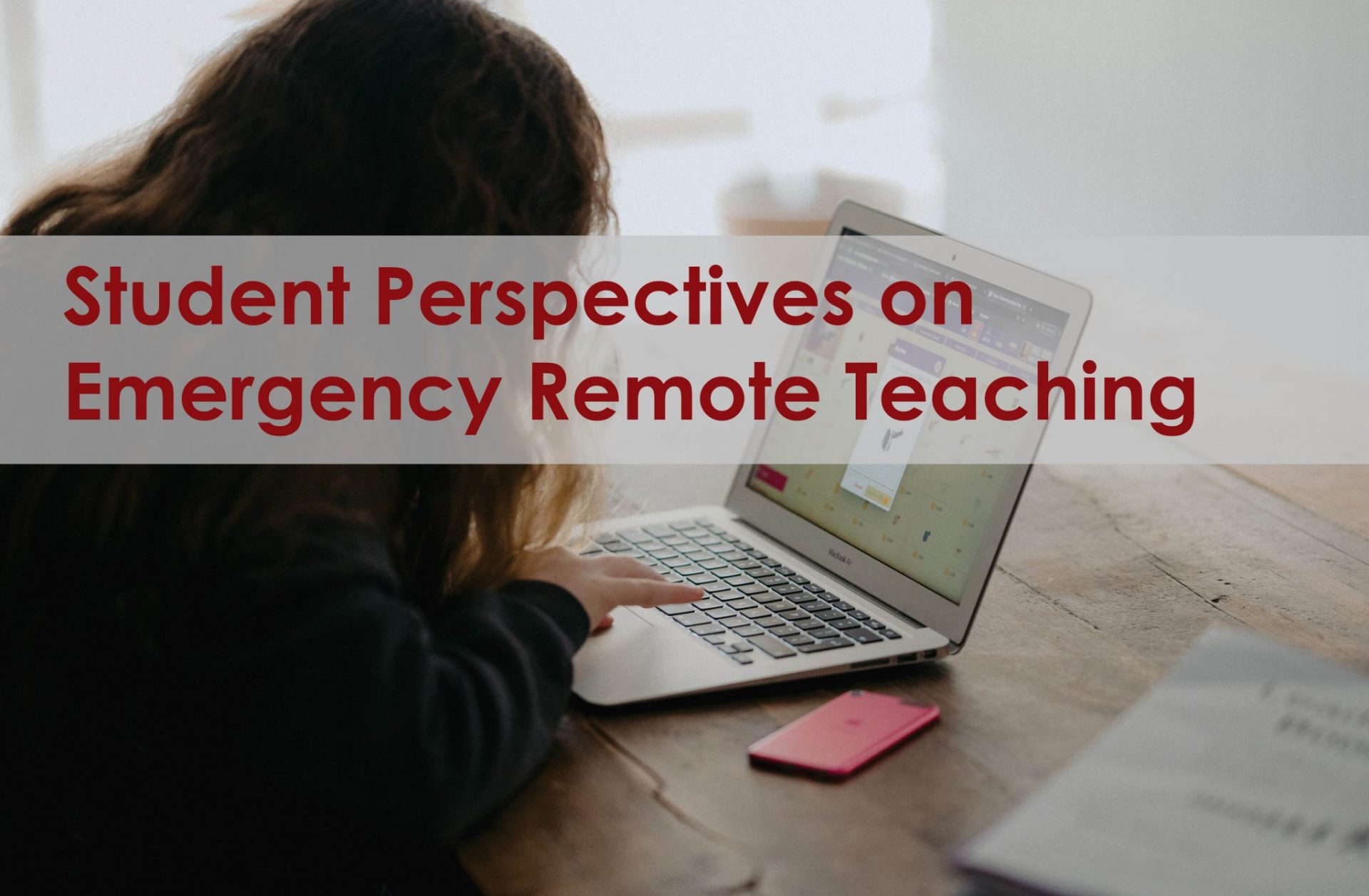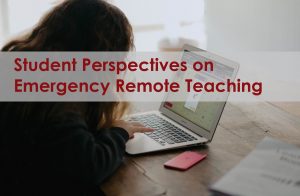The pandemic has forced educational institutions into emergency remote teaching (ERT), a rush-job version of well-designed distance education that reveals its stop-gap nature. Some of our relatives who are current college students talked to us about how the COVID-19 transition has been going, and where technology has helped or hurt.
As the higher education world has been forced to shift online, numerous experts have correctly reminded the public that what is taking place is not online learning but rather emergency remote teaching (ERT). There are, distinct differences between the two, but regardless of the descriptor, the fallout has been massive across the administration-faculty-student spectrum.
Vantage’s typical work across higher education involves intense interaction with a university’s or college’s administrative ranks. We help institutions develop technology strategies, examine needs prior to expenditures, and plan for futures yet unrealized. During the COVID-19 stay at home order, we continue to work with world-class educators on these issues and, in many instances, have been helping to make adjustments to their processes in real-time. We have also been gaining insights into ERT from a unique source – our families. From the comfort of our own kitchen tables, several Vantage employees have gotten to see and hear, up close, how higher ed students are coping, adjusting and adapting to “pandemic pedagogy.”
For this post, we asked some of our willing students about their experiences, what their suggestions for improvement might be, and what elements they think are worthwhile keeping in place as we navigate this new learning future. (Some responses have been edited for brevity.)
1. What are your biggest technology/learning challenges? Or, so far, what’s been working/not working with the pandemic situation and ERT?
Kaitlin (20-year-old college junior who was evacuated from Madrid, Spain where she had been spending a semester abroad): I had been planning to study abroad for months and was excited to join a program through Suffolk University Madrid Campus (SUMC). However, my semester abroad ended unexpectedly when the Community of Madrid announced they were closing all schools and universities on the night of March 9, 2020. I flew to the US the next day.
SUMC then tasked each faculty member with adapting their curriculum for remote students with little assistance and time for preparation. SUMC left it up to each professor to choose an online education platform, which led to me having to use three separate platforms for my four classes.
One platform in particular that proved to be user-unfriendly was Blackboard. One professor had to abandon the platform mid-semester because he was unable to figure out how to use the various features or contact us through its communication portal. A second professor posted weekly lectures on Blackboard but could not use the platform for grading or submissions. I found Blackboard to be visually overwhelming and hard to do the simplest tasks like making a discussion post.
Another platform that SUMC used during this time was Connect by McGraw-Hill Education. I found Connect easy to understand, even though I had not used it before. The online program is included when you purchase the textbook for the course. Therefore, we were able to access the textbook and all work online in one simple dashboard. There was also a function on Connect where my professor could highlight parts of the chapters, simplifying the reading for the students. Overall, I found Connect to be easier to use and more aesthetically pleasing than Blackboard.
Furthermore, many universities resorted to Zoom to maintain some consistency for classroom lectures, but with the six-hour time difference that was nearly impossible for my program. I only used Zoom once during my online education experience; I found it easy to use and I enjoyed seeing the faces of my fellow classmates, who I hadn’t seen in two months.
Robert (sports journalism major at Arizona State University (ASU)): When ASU informed me of their decision to move classes onto an online format, the biggest challenge I encountered was lack of concentration. Being a sports journalism major, my classes are particularly hands-on, which made me excited about attending classes while I was in Arizona. Online courses removed that aspect, making classes boring for me. I’m currently at home in California, which was where I was spending spring break when ASU announced that classes would be delivered online for two weeks, and then for the remainder of the semester. I’m more distracted at home than at ASU, so concentrating for online classes has been a challenge, and I didn’t bring any books or school supplies home, which made everything more difficult.
Jonathan (student at California Polytechnic University, Pomona): I think that it is more productive and enjoyable when a teacher changes their class to fit technology, rather than fitting technology into their old way of teaching. Test taking is a great example. One of my teachers realized that tests cannot be delivered the same way they are in a regular class setting. What she has done is promote group work and research to determine real-world application problems, rather than testing what students remember.
Aaron (a rising Junior at Syracuse): One of the biggest challenges with the pandemic is that professors received minimal training on how to set up online learning. Transitioning to online learning was a last-second decision, leaving the school with only a week or two to train professors on how to set up an online class. Some professors are not very skilled with technology, which showed in the quality of teaching after transitioning online.
Stephen (graduating student at San Francisco State University): One of the biggest challenges we have with ERT is the lack of resources.
We don’t have access to our library or in-person office hours. I am in my graduating year, majoring in broadcast and electronic communication arts. I saved my last semester for all of my fun production classes where I get to just create content. Now we’re in ERT classes due to the pandemic.
ERT translates relatively well for lecture-style classes, where the teacher displays the presentation within Zoom. It provides a good opportunity for students who are often too shy to raise their hand to ask a question – they can just type a question in the Zoom chat box. Anything beyond a simple lecture – a lab, a studio, an open space – doesn’t really work because students don’t have the required resources. How would you mix chemicals from home for a chemistry class? How do you handle studio production without a studio? Some things just do not work from home.
2. How do you think your ERT or online learning platform could be improved immediately?
Kaitlin: I found that contacting my professors directly and scheduling a call was the best way to stay on track. It gave me a way to better understand the assignments and receive the underlying communication that you cannot read in an email. However, this did make my classes feel more like they were independent studies rather than classes of 20+ students.
Robert: From my experiences with online classes, I have noticed how some of my courses have removed the collaborative aspect. With in-person classes, I was able to engage with other students and develop relationships with them. With online instruction, I experience collaboration in only three of my five classes.
Jonathan: I feel that teachers will have more success if they recognize the difficulty for some students to focus and study in the current situation, and then adapt teaching styles to accommodate. One of my teachers has done this. Instead of delivering hour-long lectures in the form of videos or a live class, she has recorded smaller 6- to 10-minute videos focusing on individual topics and problems. It’s effective. The TikTok platform has increased its user base during the pandemic because their content is comprised only of 14-second videos, which plays into that fact that people are having a hard time focusing at home.
3. What would you carry over from this experience when we get back to the “newest normal”?
Kaitlin: Universities need to prioritize the streamlining of online education to be in the best position if something like the pandemic were to happen again. I recommend using one online platform for all classes. This will help the students manage their work and for professors to help each other if they are struggling with the platform. SUMC should consider using a platform like Canvas, which is user friendly and infinitely better then Blackboard.
Jonathan: I feel that the changes that have occurred with testing should be carried over. One of my teachers wants to test the same way she always has despite the pandemic. To do this, she has the students use two cameras while taking the test, and students still find ways to cheat. Instead, what should be done is making tests that are designed to be worked on by groups or tests that require research rather than memorization.
Aaron: I think it is worth considering moving certain large lecture classes to an online setting even after the pandemic. I have taken multiple classes with 150+ students where there is very little interaction between the class and the professor. I don’t see any reason why these classes can’t be moved online. In addition, teachers should provide specific days and times during which they respond to emails immediately, since virtual office hours for most classes are held only once per week.
Stephen: A lot of my professors have been providing on-demand office hours; if given a reasonable amount of notice, they will do a private Zoom video call with a student. That’s been helpful and very supportive.
Robert: I hope that, if something like the pandemic happens again, professors will make more of an effort to encourage communication between students. After classes went online, I no longer speak to some of my classmates even though we were close.
Something that I’ll carry over in my daily life will be to cherish every moment with the people I enjoy being around. On my last day at ASU before spring break, I helped shoot an episode of Cronkite Sports Live, a sports show for the Walter Cronkite Sports Network. We knew it would be the last episode for a few weeks, so one of the anchors ended with “we’ll see you in a little bit.” The director, Troy, a fifth-year senior graduating this spring, wished us a happy and healthy spring break. We were oblivious to the fact that that was last time we’d shoot an episode of CSL for the rest of the school year, and the last, and most likely final, time we’d see Troy before he goes off into the real world.



